MORE LITTLE KNOWN HISTORIC SITES AROUND THE BAY OF NAPLES
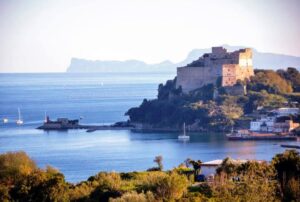
As we discovered on our recent trip to the western side of the Bay of Naples, the area is full of surprises. Every day we discovered ancient sites that have little or no information about them readily available. Many of these were very large, and all fascinating. Most were well presented, and certainly rewarding for those wanting to see ancient Roman archaeological sites other than Pompeii and Herculaneum. Popular with Italians and other Europeans for its beaches, accommodation is reasonably plentiful and, needless to say, good trattoriae and ristorantes are everywhere.
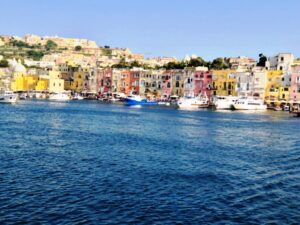
In the last story, I discussed the port area of Pozzuoli and some of its Roman and earlier Greek archaeological sites. This only touched the surface of what we were to discover a little further along the coast.
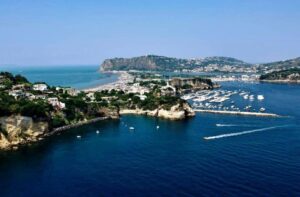
Barely 5 kms from Pozzuoli, heading west, is the ancient Roman town of Baiae—modern Baia. Although many wealthy Romans settled for Capri, Pompeii and Herculaneum, there was one place that was far more exclusive and classier than the other resorts—Baiae. Horace wrote that “there is nothing in the world more beautiful than the Gulf of Baiae.”
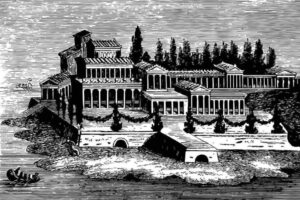
From around 80 BCE onwards, it was renowned, some would say notorious, as a resort for the Roman elite, with luxurious villas and leisure facilities such as elaborate thermal baths, and a relaxed, hedonistic atmosphere. Seneca described it as a “vortex of luxury”, “a harbour of vice” and complained about “the drunks who stagger along the beach at night and the noise of the parties held on the boats.” Julius Caesar’s summer residence was said to be grandiose, covering roughly 150,000 sq. m., Cicero had a slightly more modest villa there, and one Quintus Hortensius had a complex that was described as being of “pharaonic proportions” with an adjoining fish-farming pool. Other famous regulars to Baiae included Marius, Pompey, Lucullus and many other leading lights of the Roman world. Much of the town became imperial property under Augustus.
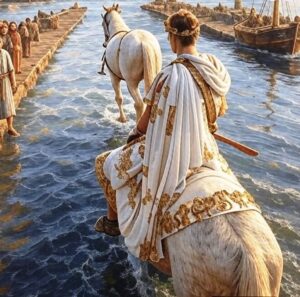
Nero had a lavish villa constructed at Baiae in the mid 1st century CE, and Hadrian died at his villa there in 138 CE. It was also a favourite spot of the emperor Septimius Severus. According to Suetonius in his ‘Lives Of The Twelve Caesars’, in 39 CE Baiae was the location for a stunt by the eccentric emperor Caligula as a response to the astrologer Thrasyllus’s prediction that he had “no more chance of becoming emperor than of riding a horse across the Gulf of Baiae.” Caligula ordered a 5 km long pontoon bridge to be built from impounded ships in the area, fastened together and weighted with sand, stretching from Baiae to neighbouring Puteoli. Clad in a gold cloak, Caligula then crossed it on a horse.

Baiae was also renowned for the quality of its oysters and baths of natural waters and hot springs, said to have health benefits. Its decline was a result of the phenomenon called bradyseism between the 3rd and 5th centuries CE, that became particularly difficult to deal with as substantial portions of the land became submerged by the sea. By the 8th century the lower part of Baiae had disappeared, and it was ultimately abandoned because of the silting up of Lake Lucrinus. The bay of Baiae constitutes the remains of an ancient crater that became submerged along with Roman buildings that were located on a sandy stretch along the crater’s slopes.
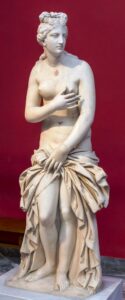
Submerged treasures have come to light over the last century. An exquisite statue of the goddess Aphrodite–a 2nd century CE Roman version of the much admired ‘Syracuse Aphrodite’ from the 4th century BCE–was located around 1803. In April 2023 the sunken remains of an ancient Roman villa, including marble tiled flooring, numerous marble columns and an ornate mosaic were discovered by underwater archaeologists from the Campi Flegrei Archaeological Park. There are 8 underwater sites, ranging from a depth of 5m to 13m, that are very popular for snorkelling and scuba diving.
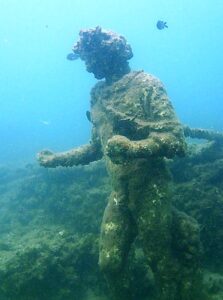
For example, the Emperor Claudius’ Nymphaeum is at a depth of 5m, just off Punta Epitaffio at Baiae, and a spa complex, the Thermal Baths of Lacus, at depth of 4m, which once overlooked the ancient port of Baiae, was recently discovered, restored and opened to the public in 2020. There are numerous other such dive sites in this area.
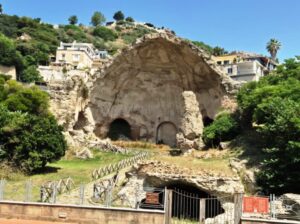
Close to the coast is the Parco Archeologico delle Terme di Baiae—the thermal baths archaeological site. This large and very impressive site has several domed baths buildings such as the so-called Temple of Mercury, the Temple of Venus and the colossal Temple of Diana, which had been decorated with marble friezes depicting hunting scenes.
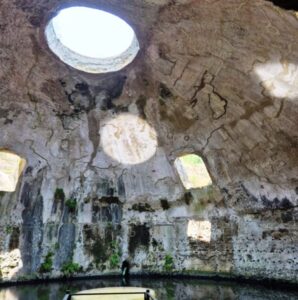
These were not temples, but parts of the thermal baths complex, which had both public and private baths facilities. They were filled with warm mineral water that was piped from underground hot springs, as many still are today. Roman engineers constructed a complex system of chambers that channelled underground heat into facilities that acted as saunas. The baths were both for recreational use and medical treatments for various illnesses, and physicians would attend their patients at the springs.

After the entrance to the Parco, the first building you come to is the Villa dell’Ambulatio, which occupies six terraces, the highest housing domestic quarters, with peristyle courtyard, living rooms and bedrooms around a large central hall which opened onto the surrounding landscape.

The entire complex once had marble or black and white mosaic floors. There was also a laconicum (sauna), decorated with paintings on the stucco walls, and large marble statues were found in various parts of the complex.
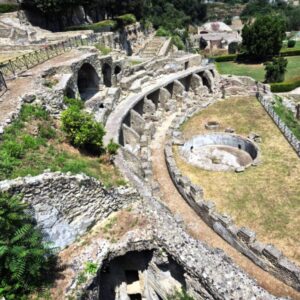
The whole thermal baths complex had function rooms, decorative fountains and deep water storage cisterns. There was every convenience and luxury catering to its clientele and what they expected in their holiday resort of choice.
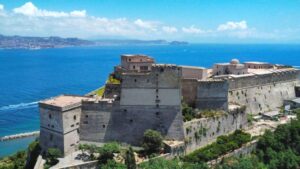
Barely 2 kms further along the coast, almost at the western end of the gulf, just before Cape Miseno, is an enormous fortress castle.
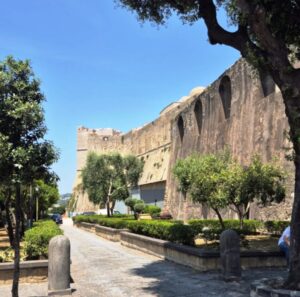
For centuries, between 1500 and the unification of Italy in 1861, it was an important defensive bulwark along the coastal approaches to Naples, which was then the capital of the Kingdom of the Two Sicilies. The fortress extends over 45,000 sq.m and reaches a height of 94m above the sea. It was built in 1495 by the then ruling—but fading—dynasty of the Kingdom of Naples, because the Aragonese king Alfonso II needed to defend his realm against imminent invasion by the forces of Charles VII of France.
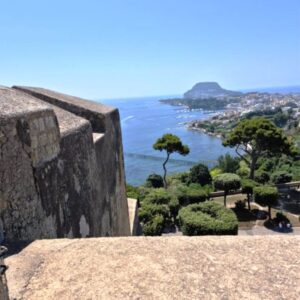
The fortress was built on the site of a Roman villa, once thought to have been the one that belonged to Julius Caesar, but now thought to have been Nero’s. After the new Spanish dynasty took over in the early 1500s, the fortress was expanded greatly under the viceroy, Toledo. This was a necessity as an eruption in 1538 had caused great damage. It was expanded yet again under the Bourbons in the late 1700s. The fortress castle had numerous functions. It hosted important visitors to the kingdom and served as a base under the Spanish for early studies of volcanism in the region. It also served as a prison and was the site of grisly executions. When its military role became redundant, it was officially “demoted” in 1887. It became a military orphanage in 1927 for the children of soldiers who had fallen in WWI. The castle became much neglected before and after WWII, and for a while after the earthquake of 1980, it served as a makeshift shelter for locals displaced from their homes.
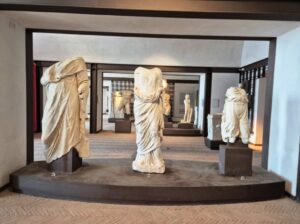
In 1993, the fortress became what is now the Archaeological Museum of the Campi Flegrei (Phlegraean Fields). It has an impressive display, both outdoors and inside, dedicated not just to the history of the castle, but to the wealth of archaeological material within the region, found on land and underwater. The castello dominates the entire Bay of Pozzuoli. It’s rich in cultural experiences, and as you can imagine, the views from the ramparts up and down the coast, are stupendous.
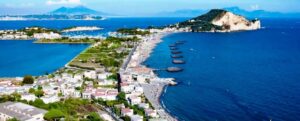
One of my personal aims on this trip was to see if there was anything remaining of the family villa of the Roman writer, Pliny the Younger. His is the only eye-witness account to the eruption of Mt Vesuvius in 79 CE that exists. He was only 17 years old at the time, and was on holiday at Misenum (modern Miseno), and sitting reading in the garden when he looked up and saw the billowing mushroom cloud in the distance to the south. Summoning his mother and his uncle—referred to as Pliny the Elder—a prominent historian, naturalist, scientist and lawyer as well as being praefectus classis (admiral) of the Roman fleet. In fact, modern day Miseno is still a base for the Italian navy.
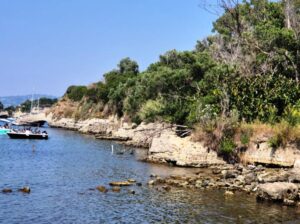
Both Plinys quickly took ship down the coast to Pompeii with the intention of rescuing an old family friend who was on holiday at her villa. The Elder instructed his nephew to stay on board while he went ashore. They actually made it back through the town with the elderly friend, only to fall on the beach. His body was found 3 days later on the beach after the plume of smoke and gases had dispersed. His body displayed no apparent external injuries, but since he was a corpulent man who suffered from a chronic respiratory condition, it was assumed he had died inhaling hot toxic gases. The Younger Pliny survived to recount this experience in a letter to his good friend Tacitus. As his uncle had not married and had no children, Pliny the Younger inherited his considerable fortune including numerous properties.
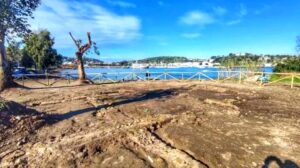
Unfortunately, although we were able to identify what was probably the site of the Pliny family villa, nowadays it’s just a cleared field with a few large blocks of stone outlining the floor plan and others just lying about. However, I was thrilled to be standing on the spot where one of ancient Rome’s greatest writers had spent his holidays.
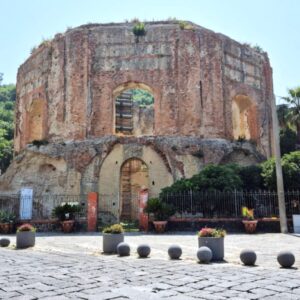
There is such lot to see in this part of Italy, and not just the many ancient sites, but beautiful coastline and countryside. It’s also very easy to take ferries from either Naples and Pozzuoli to the beautiful islands of Capri, Ischia and Procida out in the Bay. It’s a mystery to us that this fascinating and rewarding region is not better known outside Italy.



Leave a Reply